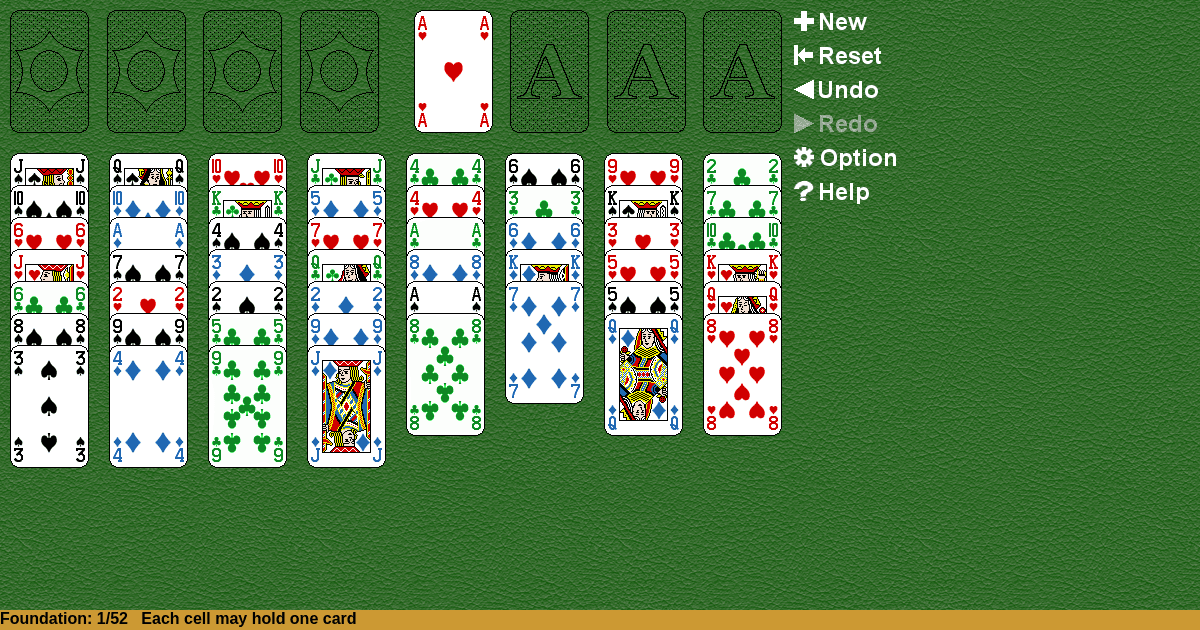Baker's
Home |
How to play |
FAQ |
About
How to play Baker's?
Game Objective:
The primary goal in Baker's Solitaire (commonly referred to as Baker's Game) is to move all cards from the tableau and cells to the four foundation piles, building each foundation in ascending order by suit from Ace up to King.
Setup & Layout:
- Deck Used: Standard 52-card deck.
- Initial Arrangement:
- Deal all 52 cards face-up into eight tableau piles.
- Four tableau piles contain seven cards each.
- Four tableau piles contain six cards each.
- Place four cells (also called reserves) above the tableau piles. Each cell can hold only one card at a time.
- Place four foundation piles next to the cells. These start empty.
- Play Areas Defined:
- Tableau: Eight piles in the main play area, each with cards fanned face-up.
- Cells (Reserves): Temporary storage spaces, each holding one card.
- Foundations: Four piles, one for each suit, built from Ace to King.
- Face-Up/Face-Down: All cards are dealt face-up; there are no face-down cards in Baker's Solitaire.
Baker's Solitaire Rules:
- Card Movement Principles:
- Only the top card of each tableau pile and any card in a cell are available for play.
- Cards may be moved between tableau piles, to cells, or to foundations.
- Building Sequences:
- Tableau piles build down in suit (e.g., 7♠ on 8♠).
- Foundations build up in suit, starting with Ace and ending with King (e.g., Ace♣, 2♣, …, King♣).
- Movement Restrictions:
- Only one card may be moved at a time. However, if enough empty cells and tableau piles are available, you may move sequences as a shortcut, simulating what could be achieved by moving cards individually.
- Cells: Each cell can hold only one card. Cards in cells can be moved back to the tableau or to the foundations.
- Empty Tableau Piles: Any available card may be played to an empty tableau pile.
Gameplay:
- Typical Sequence of Actions:
- Move available cards between tableau piles, cells, and foundations, following building rules.
- Use cells to temporarily store cards, facilitating access to needed cards or sequences.
- Build foundations in ascending order by suit whenever possible.
- Introducing New Cards:
- There is no stock or redeal; all cards are in play from the start.
- The only way to access buried cards is by moving cards above them using legal moves.
- When No Legal Moves Remain:
- If no further moves are possible and not all cards are in the foundations, the game is lost or unwinnable.
Winning & Losing Conditions:
- Winning Condition:
- The game is won when all 52 cards are built onto the four foundation piles in ascending order by suit, from Ace to King.
- Losing/Unwinnable Condition:
- The game is lost if no legal moves remain and not all cards are in the foundations. There is no redeal or reset.
Special Rules & Edge Cases:
- Filling Empty Spaces:
- Empty Tableau Piles: Any available card may be placed in an empty tableau pile.
- Empty Cells: Any single card may be placed in an empty cell, but only one card per cell.
- Sequence Movement Shortcut:
- While only one card can be moved at a time, some digital implementations allow moving sequences if enough empty cells and tableau piles exist to simulate moving them individually.
- No Redeal:
- There is no redeal or stock; careful planning is required to avoid unwinnable positions.
- Suit Restriction:
- Unlike FreeCell, tableau building is strictly by suit, not by alternating color, making Baker's Solitaire more challenging.
Key Terms Defined:
- Tableau: The main area of play with eight piles where most card movement occurs.
- Cell (Reserve): Temporary holding area for single cards to facilitate strategic movement.
- Foundation: The target piles for each suit, built in ascending order from Ace to King.
This guide outlines the core mechanics and unique rules that distinguish Baker's Solitaire as a challenging and strategic patience game.

Solitaire Collection
About Baker's
Rate (Baker's)
4.7 / 5
1,916 votes



























































